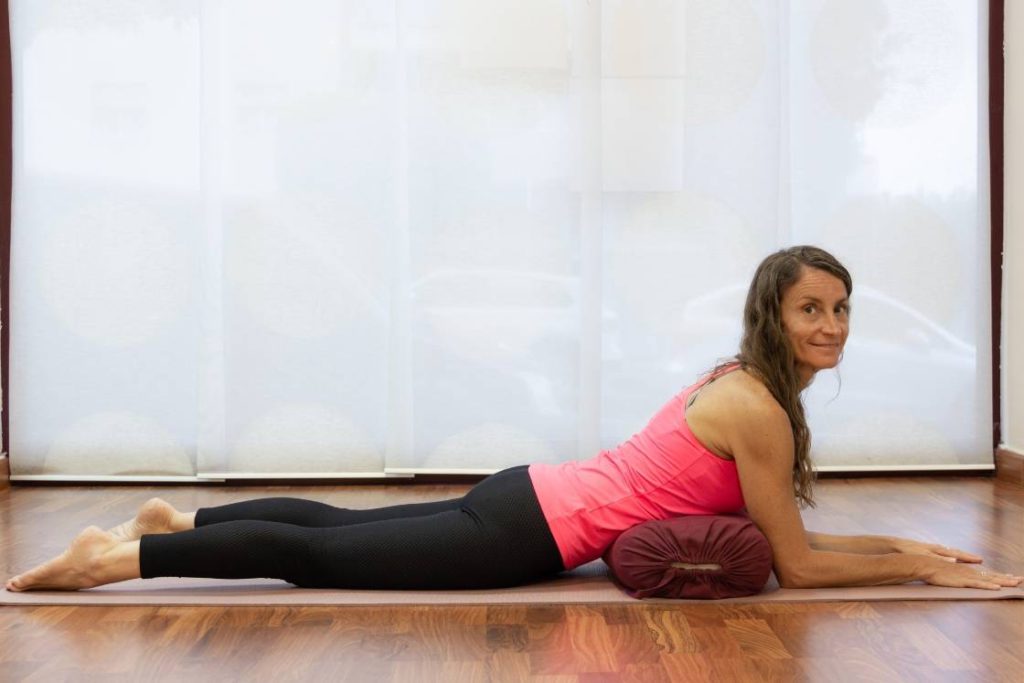
Tired of struggling to get into the cobra pose? Check out this easier variant of it, named as salamba bhujangasana.
Salambha bhujangasana is a beginner level posture performed in the prone position. This is a gentle back bending posture benefitting the chest, lower back, and abdomen. It also stretches the arms, shoulders, and neck muscles.
Getting into the sphinx pose is easy and can be achieved by lying in the prone position with forearms besides the head. From there, lift the chest and head pressing the forearms to the floor.
The pose is most suitable to get rid of body fatigue and feel rejuvenated.
Salamba Bhujangasana Meaning
The name of the posture is derived from Sanskrit, where “salamba” means “supported”, “bhujanga” refers to “serpent/cobra”, and asana is “pose”.
The resemblance of the body holding the pose with the cobra raising its hood appropriately named the pose as salamba bhujangasana.
Its English name is sphinx pose. The reason behind this is its resemblance to the mythical sphinx of Giza.
It is a great posture to stretch the spine and warms up the body for advanced backbends.
Sphinx Pose Practice Guide

Precautions & Contraindications
- Do not practice this pose with spinal injury or stiffness in the back.
- Do not try the pose with broken ribs or wrist.
- The recovery period after recent abdominal surgery is not a suitable time for salamba bhujangasana.
- Pregnant women must avoid this pose.
- People suffering from spondylitis or neck issues must not strain the neck while practicing this asana.
Preparatory Poses
The body can be prepared for salambha bhujangasana by performing Phalakasana (Plank Pose) first.
How to Do Salamba Bhujangasana (Steps)
- Lie down in the prone position with forehead resting on the floor.
- Lift your head placing the chin to the floor.
- Bring hands forward placing the forearms beside the head.
- Align the elbows underneath the shoulder.
- Inhale, pressing the forearms to the floor lift the chin, chest, abdomen off the floor.
- Arch the neck taking the ears away from the shoulders.
- Stretch the legs outwards, and keep breathing.
- Stay in the pose for 5-10 breaths fixing the gaze upwards.
- Exhale bringing the chest, abdomen, and forehead to the floor.
- Extend the arms over the head and relax in savasana.
- Repeat once more if possible and relax.
Follow-up Poses
- Superman Pose (Viparita Shalabhasana)
- Cobra pose (Bhujangasana)
- Bridge Pose (Setu Bandha Sarvangasana)
Props and Modifications

- Blocks – Rest the forearms on the blocks to increase the curve in the lower back. It enhances the stretch while holding the pose.
- Bolster – Place a bolster under your chest while holding the final pose. It aids in balancing the upper body off the floor and also helps opening the chest.
- Rolled towel/ blanket – Place a rolled towel or blanket under your pelvic zone. This prop will enhance the stretch in the lower back and upper body.
- Yoga belt – Tie the belt around your feet and then perform the asana. It maintains the position and integrity of the legs while stretching the full body to attain salamba bhujangasana.
Variations

- Sphinx pose with bent knees – Perform sphinx pose stretching the spine and legs. Raise the lower legs with heels facing the ceiling by bending the knees.
- Sphinx pose with Eagle legs – Perform salamba bhujangasana and then bent your right leg at the knee. Hook your left leg behind the right knee and entwine the right foot around the left ankle. The legs position is like the position of hands in eagle pose.
- Sphinx pose with half frog pose legs – After salambha bhujangasana, drag your right knee outwards and right foot lies beside the left knee.
- Cobra Pose – This pose is similar look variation of the sphinx pose in which the body in the prone position supported on the hands instead of forearms.
From the prone position, hands come beside the chest. Pressing the palms to the floor, lift your head, chest, abdomen off the floor. Keep the elbows soft and hold the pose.
Therapeutic Applications
- Salamba bhujangasana is a perfect stretch for the spine. Therefore, it is beneficial in relieving any spinal pain, viz neck, or back pain.
- On practicing sphinx pose, people suffering from mental issues like stress, anxiety, etc. get control over their mental state.
- It is also therapeutic in relieving sciatica pain.
- Asthma patients also get benefits from performing salambha bhujangasana.
- This pose is also suitable for improving posture and any spinal misalignment.
Salambha Bhujangasana Benefits
1. Spine strengthening
Salamba bhujangasana is a gentle back bending posture. It increases spine flexibility. The vertebrae are stretched and this leads to making the spinal column stronger.
2. Stretches shoulders, chest, and abdomen
In this pose, the chest and abdomen are lifted off the floor. The shoulders are also actively engaged. It stretches and strengthens the muscles of these regions.
3. Strengthens the hip joints
This pose stretches the hips and psoas muscles. It increases the firmness of buttocks and improves the flexibility of hip joints.
4. Stimulates internal organs
The abdominal stretch involved massages the internal organs like kidney, liver, and digestive organs. The stretch in the chest stimulates the lungs and increases breathing capacity.
5. Improves blood circulation
Salamba bhujangasana is a heart opener pose, it lifts up the heart increasing its efficiency. This leads to enhanced blood flow to the cells and maintains heart rate.
6. Benefits the endocrine system
Salamba bhujangasana activates stimulates adrenal and thyroid gland. This regulates the secretion of hormones and maintains the endocrine system.
7. Chakra Activation
Along with all the physical benefits, sphinx pose activates two energy chakras. The stretching of the chest and neck activates the Heart (Anahata) chakra and Throat (Vishuddha) Chakra.




